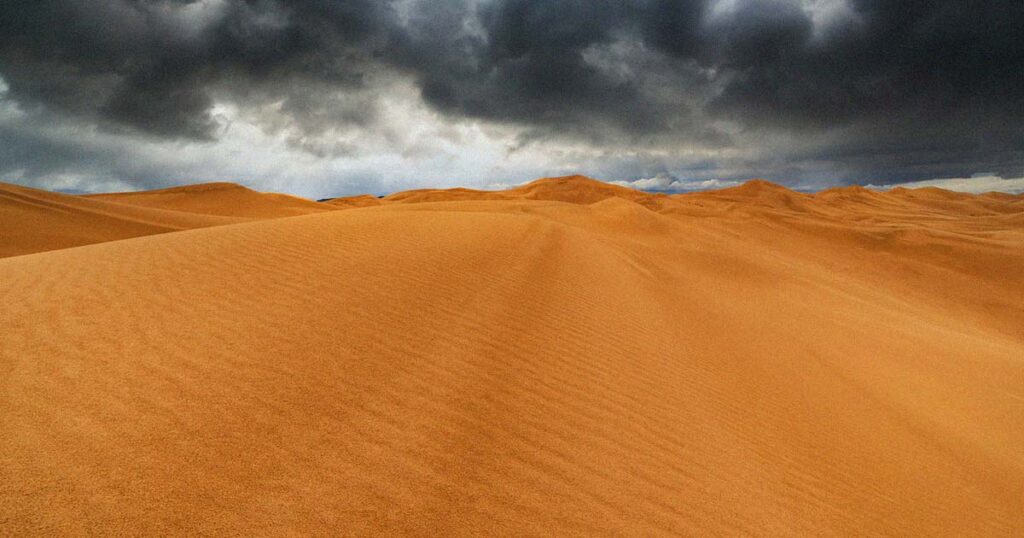The climate crisis that has plagued our planet has recently manifested in a surprising and extreme weather event within the arid expanse of the Sahara Desert. A region in southeastern Morocco, typically characterized by its dry conditions, recently experienced an unprecedented deluge of rainstorms. This unexpected shift transformed parts of the Sahara into stunning lake-filled oases, a stark contrast to the usual parched landscape. According to reports by The Associated Press, these rainstorms brought more precipitation in just a matter of days than the average annual rainfall that many areas in the region receive, highlighting both the rarity of such events in the desert and raising questions about the long-term impacts of climate change on global weather patterns.
Rainfall in the Sahara is a rare occurrence, particularly during the late summer months when the region is especially dry. For instance, an astonishing rainfall event in the town of Tagounite resulted in nearly four inches of rain within a single day, a volume that is incredibly significant for a place where annual totals typically hover below ten inches. Houssine Youabeb, a representative from the Moroccan General Directorate of Meteorology, reported that these levels of rainfall had not been witnessed in the region for three to five decades, suggesting a notable deviation from historical weather trends. The significance of this heavy rain extends beyond immediate relief, as it has sparked hope that it could eventually help replenish the area’s scarce subterranean aquifers, which are vital for local communities.
While this unusual weather phenomenon offered a momentary respite in the form of rain, the broader implications for the region’s climate are concerning. Meteorological experts suggest that such an influx of moisture may lead to substantial changes in the local climate dynamics. The unexpected storms could generate more atmospheric water content, creating conditions that favor the development of further precipitation events in the future. This potential for increased rainfall could foster hope for those enduring the prolonged drought conditions in the region, as evidenced by NASA imagery showing water flowing into Lake Iriqui, a lakebed that has remained dry for about fifty years.
Despite the potential long-term benefits of this rainfall event in alleviating drought, it is crucial to acknowledge the immediate dangers that accompany such extreme weather patterns. Tragically, the flooding resulting from the heavy rains has already caused the loss of over twenty lives in Morocco and Algeria. This situation underscores the dual nature of climate change, where extreme weather can bring both relief and peril, further complicating the assessment of its impacts on vulnerable regions. The rainfall serves as a reminder of the unpredictable consequences of climate change, reinforcing the urgent need for a thorough understanding of how these events are connected to larger global trends.
The dramatic shift in weather patterns in the Sahara raises important questions about the interactions between climate change and regional ecological systems. As scientists continue to investigate the precise causes of the sudden storms, they grapple with the broader implications for environmental stability in the face of global warming. Understanding these phenomena is essential, not only for predicting future weather events but also for developing strategies to mitigate challenges that vulnerable communities face. The notion that such extreme weather could become more common due to climate change aligns with predictions from climate models, compelling a reevaluation of how societies adapt to shifting climatic conditions.
In sum, the unexpected rainfall in southeastern Morocco represents a multifaceted narrative of climate change’s potential to disrupt established weather patterns while simultaneously offering brief relief to long-standing drought conditions. While the immediate benefits of replenished aquifers and the creation of temporary oases might provide hope for affected populations, the concurrent dangers of flooding and loss of life highlight the complex nature of these climate events. This duality serves as a poignant reminder of the need for comprehensive climate action and adaptation strategies that account for both the unpredictability of weather patterns and the ongoing challenges posed by climate change in arid regions across the globe. As the world grapples with the ensuing crises of climate, events like these reiterate the importance of global attention and responsive policies to protect the most vulnerable aspects of our planet’s ecosystems and communities.

